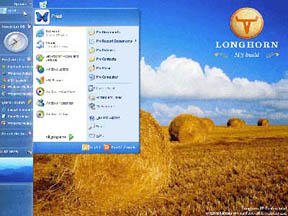Have you been hearing whispers about a new version of Microsoft Windows operating system called Longhorn?
If you did, you either have insider information or heard it from Seattle resident Brian Livingston. He is a contributing editor and columnist for InfoWorld magazine and has authored almost a dozen best-selling books on Microsoft, including his recent Windows ME Secrets.
Brian took a few minutes to give us the scoop on what hes been hearing about Microsofts next generation operating system, code named Longhorn, and how it will effect Windows users and Microsofts anti-trust restrictions.
Q: Lets talk about the recent unauthorized back-door early alpha pre-release of Longhorn operating system from Microsoft. Was this early leak a mistake on Microsofts part?
Livingston: I dont think Microsoft was ready to release a version of its new consumer edition of Windows yet. This might have taken them by surprise.
Its really going to be an amazing change for users of Windows. I dont think were going to see a real consumer product until around 2005, but I think people should start preparing for the changes now.
Q: Lets talk about Longhorns concept, the direction its going and how it will change our current experience with Windows.
Livingston: Longhorn will probably be called Windows 2005 or a name that doesnt have Windows in it. The new version of the operating system will not run any of your existing Windows software. Microsoft has said that it is going to have to rewrite all of the Microsoft Office suite, and other people are going to have to rewrite their packaged and custom applications as well.
The benefit of that is Microsoft is starting to take seriously all the problems people are having with security leaks and patches theyre having to put on Windows and the kind of e-mail viruses people have been getting for years.
The Longhorn version of Windows should actually cut down on that a great deal because Microsoft pays an incredible amount of money when people contact customer support with problems.
Rewriting Windows so it wont have such security problems will be so attractive to people that companies and individuals will switch over to this new version of Windows almost immediately after it comes out in 2005 or whenever.
Q: Ive heard this new version will have changes in the file system structure. Is that a way to cut down on viruses that happen to certain file structures?
Livingston: It does give you more security. But the new file systems that Microsoft is talking about is actually something theyve been working on in a project called Cairo for over five years.
This new file system will allow you to look through all your files. For example, you can see all the music files, files by a certain artist, files in a certain format, across all disk drives. Youll have much more of an ability to find the stuff you want without having to look through whole lists alphabetically.
Q: Will the file structure be like what you see in the Macintosh?
Livingston: The reason Microsoft didnt come out with this five years ago is that its very difficult to do.
It goes beyond the Macintosh filing system. Its almost like your entire computer is a search engine. If you said, Let me see all the MP3s or Let me see all my charts and graphs, you would see that.
I think Microsoft has had difficulty getting people to upgrade to Windows XP because the differences werent obvious. But the differences will be very obvious in Windows 2005.
I keep calling it Windows, but maybe we should touch on the fact that Microsoft wont call it Windows because if it doesnt run any Windows software. If Microsoft calls it something other than Windows, then it would be completely free from the anti-trust judge who is ruling over them for the next several years.
By calling it something other than Windows, they then would not have to worry about things like not being able to integrate certain software into the system. They are free from those restrictions.
Q: The actual screenshots of the pre-release version look an awful lot like XP. Will they revamp the look and feel?
Livingston: I think they are planning to revamp a lot of aspects. One of the biggest interface changes that I think is coming up in Windows is called Sideshow. This is a new user interface which kind of bounces off the old idea that you were going to have Windows on your desktop that would constantly feed you new sources of information – sort of like the old push technology. Sideshow is like a permanent strip of information that could, for example, be on the right hand side of your screen.
It could have all of your instant messaging buddies; it could have the traffic cams based on the routes you usually drive and maps that would show the best routes to take you where you want to go. The Windows operating system would become a gigantic thermometer or gyroscope showing you whats going on in the world out there. Anytime you want to look at it, that information would be available to you.
Q: They tried that concept with Windows Active Channels a few years ago. Is that whats coming back, along with a little more power combined with their new spot technology?
Livingston: Active Channels was taken out of Windows because it had a performance hit. It took some CPU cycles to do and there wasnt actually that much content that was available then. But today, and certainly by 2005, youll have feeds of information from a variety of sources on the Internet and it will be much easier to subscribed to something youll actually want to be taking up valuable real estate on your desktop.
Q: The things you are talking about are new information to a lot of people. I know you have your ear to the ground through your tip site at www.BriansBuzz.com. Are you talking about things that are still very proprietary to Microsoft and kept secret? How did you find out?
Livingston: Various people who have been getting some of the early test releases of the software do leak it. You can find leaks on various places on the Internet. Unfortunately, they will be there one day and gone the next.
I have started a newsletter called Brians Buzz on Windows at www.BriansBuzz.com where I put out this information that readers send to me. As the Windows Longhorn release comes closer, we will have better information about whats going to be in it and, more importantly, how people need to be planning for it. If they have to rewrite older Windows software for it to run, now would not be too soon a time to start.
Q: Are you getting any fallout from Microsoft? Are they upset with you?
Livingston: To be honest, I have never had a contact from Microsoft for any of the 10 Windows Secrets books that Ive written. Some of the people at the top of Microsoft havent been too happy with me, but the programmers with Microsoft usually have been very, very nice to me because they recognize that I realize their professionalism and skill, and Im not trying to criticize them.
Im usually trying to show people how to use the features that these programmers have put in that just didnt get into the manual Microsoft gives you with this product.
For more information about Livingston, visit www.brianlivingston.com. To send him a tip or subscribe to his newsletter, visit www.BriansBuzz.com.
Next week: Part 2 of our conversation with Brian Livingston on the future of Microsoft Windows. The full audio interview can be heard at: www.webtalkguys.com.
Dana Greenlee is co-host, producer and engineer of the WebTalkGuys Radio Show, a Tacoma-based radio and Webcast show featuring technology news and interviews.







